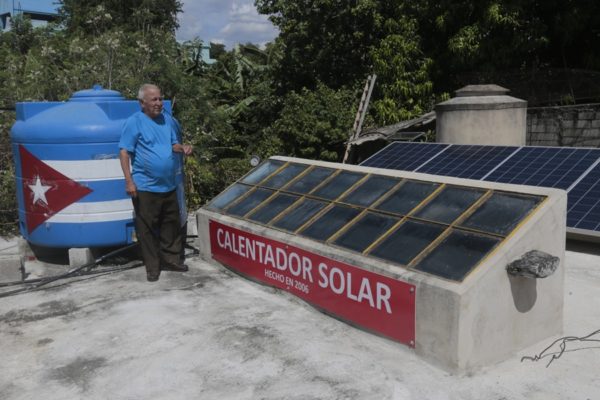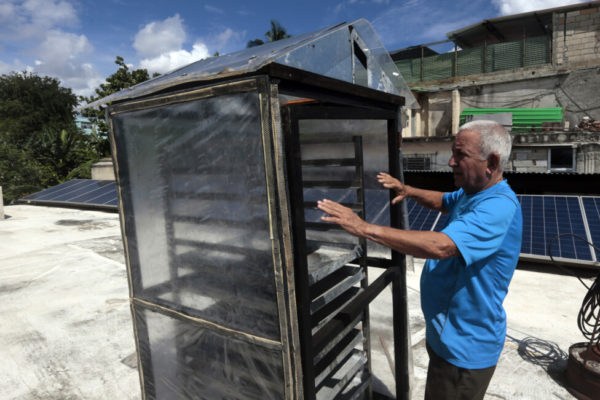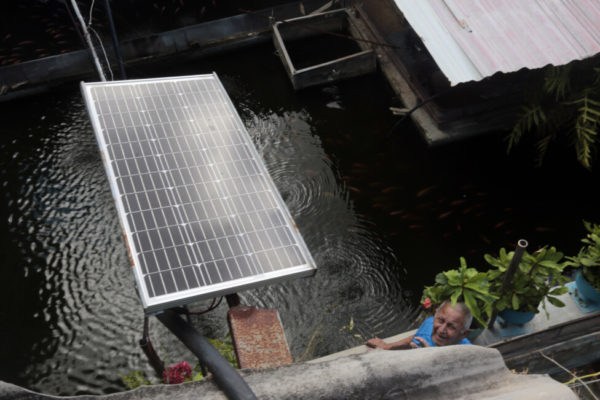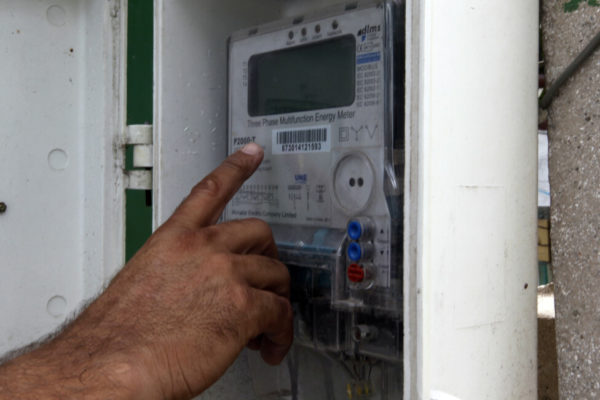One Cuban Allies with the Sun for Sustainable Living

A small number of Cubans are generating their own energy and even sell to the national grid.
By Luis Brizuela (IPS)
HAVANA TIMES – After modeling a boiler, installing photovoltaic panels, and putting together a device to dehydrate food with the help of the sun, Felix Morffi is setting up his home as a space to produce and promote renewable energy in Cuba.
With two tanks, glass, aluminum sheets, as well as bricks, sand and cement for the installation, this 86-year-old retiree created in 2006 the solar-powered boiler that satisfies his domestic needs and he shows it off proudly.
“You build it today and you have hot water tomorrow; anyone can do it, and it’s even better if you have a bit of advice,” emphasized the former technician who used to repair machines and tools.
A magnet treats the water with a purification system that makes it suitable for human consumption, without additional energy expenses.
He also has a group of 16 photovoltaic panels on the roof of the house, which were imported in 2019, and they provide 5 kilowatts of power (kWp) and he helps out at the small car repair workshop for state-led and private companies.
This is an entrepreneurial venture that Morffi has set up on a part of his land, in the Regla municipality, one of Havana’s 15 cities.
In addition to covering domestic energy needs, surplus electricity is sent to the National Energy Grid.
“We receive a monthly average of just over 2000 pesos (approximately 83 USD, at the official exchange rate),” for this energy boost and as part of a contract with Cuba’s Electricity Union, belonging to the Ministry of Energy and Mines, “which is more or less the amount we paid for our consumption in the same time period,” Morffi told IPS in an interview at his home.
However, he believes that the 12.5 cents of the dollar rate for every kiloWatt (kW) of energy provided to the grid should be raised if they want more people to contribute to this energy source.
Since 2014, Cuba has a policy to develop renewable energies and their efficient use, and in 2019, Decree-Law 345 established regulations to increase participation in electricity generation and thereby gradually reduce fossil fuel consumption.
Laws have been added such as the tax exemption on assets for 8 years for foreign companies that undertake sustainable electricity generation projects.
Other decisions look to encourage self-sufficiency with decentralized generation and selling surplus to the state electric company, as well as duty-free imports on non-commercial photovoltaic systems, parts and pieces.

Solar energy potential
According to many studies, Cuba receives an average solar irradiance of over 5 kW per m2 per day, which is considered high and presents great potential on this archipelago with over 110,800 km2 and an annual average of 330 sunny days.
Up until late 2021, approximately 500 million USD had been invested in expanding solar, wind, biomass and hydroelectric energy sources, according to figures from the Ministry of Energy and Mines.
The solar energy program appears to be the most advanced and with better opportunities for growth.
Solar photovoltaic parks installed in the country supply 238 megawatts, over 75% of the renewable energy produced.
Meanwhile, over 160,000 homes out of the 3.9 million residences nationwide – especially in mountainous and hard-to-reach areas -, receive electricity from solar photovoltaic modules, government statistics show.
However, over all clean energy sources only make up 5% of the island’s electricity generation, a panorama the Government wants to radically transform, with an ambitious target of reaching 37% by 2030.
Substantial change to Cuba’s energy matrix is a matter of national security, as it is very dependent on fossil fuel imports and has been hit hard by constant energy deficits.
The island is experiencing a crisis right now in electricity generation with blackouts up to 12 hours long, or even longer in some areas, given the deterioration of its 20-block thermal power network, with an average of 30 years of use and in desperate need of regular repairs.
Add to this the increase of global prices of diesel and fuel oil, as well as shortages of spare parts to keep motors and generators, that use these fuels, running in 168 municipalities.

Obstacles
The Cuban Government has pointed out that the US embargo has put a break on renewable energy growth, and blames it for discouraging possible investors and blocking the island’s access to modern components and technology.
On the other hand, inflation, the partial dollarization of Cuba’s economy and severe shortages of basic essentials, including food, leaves most families without a lot of options to opt for self-sufficient clean energy production, even when they recognize the positive impact it has for the environment.
One of the state companies sells and sets up solar panel systems of 1 kWp for approximately 2,300 USD, in a country where many do not even make $50 a month at their state jobs, although some can apply for a bank loan to install them.
Citizens with solar systems consulted by IPS highlighted the problems they have to accumulate energy for night-time use, during blackouts or on cloudy and rainy days, taking into account how expensive batteries are.
According to Morffi, personnel involved in many procedures need to receive further training, and he listed delays of over a year between signing the contract with the Electricity Company and the beginning of payments for electricity surplus, and “inconsistency in equipment set-up”.
Even though there is a national policy about renewable energy sources, “there is still a lack of awareness and not a lot of desire to do things and do them properly… we have to raise awareness among the people involved,” he argued.

Collected renewable energy
Morffi believes that unlike current economic conditions, we can make the most of natural elements with a bit of ingenuity, because “the sun comes out for everyone; the wind is there and it doesn’t cost you anything, wealth is in the mind.”
He shows a dryer that uses the heat of the sun to dry out fruit, spices, and root vegetables, which he put together with mostly recycled products, such as wood, plastic, acrylic cuttings, and aluminum sheets.
Other equipment would imply an important investment such as that of three small 0.5 kWp wind generators that he plans to import and a new batch of 4.0 kWp solar panels, which he will need to ask a bank loan for.
At the back of the house, a small photovoltaic panel keeps water flowing in a well for domestic birds and the artificial fish bowl with different ornamental fish wriggling about, as well as tilapia for the family’s consumption.
A small biodigester, about 4 m2, is also well on its way to being built, with the objective of using is to cook with methane gas obtained from the decomposition of animal fecal matter.
According to Morffi, who manages these projects with support from his family, his home is on the way to becoming an experimental area on how renewable energies can be used.
A specialist course needs to be set up there, so that students can learn about the subject in situ.
This is in the design phase for now and he is having conversations with possible sponsors, but this local development project could even install “solar-powered boilers in places in the community such as the family doctor’s office, a day care center and a canteen for the elderly,” Morffi pointed out.
He stressed that the idea needs to receive support from international cooperation organizations, Regla’s municipal government, and the NGO Cubasolar, an association dedicated to promoting renewable energy and eco-friendly practices, which Morffi has been a member of since 2004.
“I am available to advise anyone who wants to set up solar panels, boilers or dryers, anything that has to do with renewable energy. I have the expertise, experience and can help,” he highlighted.





